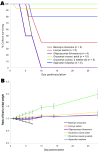Experimental infection of potential reservoir hosts with Venezuelan equine encephalitis virus, Mexico
- PMID: 19331726
- PMCID: PMC2671456
- DOI: 10.3201/eid1504.081008
Experimental infection of potential reservoir hosts with Venezuelan equine encephalitis virus, Mexico
Abstract
In 1993, an outbreak of encephalitis among 125 affected equids in coastal Chiapas, Mexico, resulted in a 50% case-fatality rate. The outbreak was attributed to Venezuelan equine encephalitis virus (VEEV) subtype IE, not previously associated with equine disease and death. To better understand the ecology of this VEEV strain in Chiapas, we experimentally infected 5 species of wild rodents and evaluated their competence as reservoir and amplifying hosts. Rodents from 1 species (Baiomys musculus) showed signs of disease and died by day 8 postinoculation. Rodents from the 4 other species (Liomys salvini, Oligoryzomys fulvescens, Oryzomys couesi, and Sigmodon hispidus) became viremic but survived and developed neutralizing antibodies, indicating that multiple species may contribute to VEEV maintenance. By infecting numerous rodent species and producing adequate viremia, VEEV may increase its chances of long-term persistence in nature and could increase risk for establishment in disease-endemic areas and amplification outside the disease-endemic range.
Figures



Similar articles
-
Venezuelan equine encephalitis virus, southern Mexico.Emerg Infect Dis. 2004 Dec;10(12):2113-21. doi: 10.3201/eid1012.040393. Emerg Infect Dis. 2004. PMID: 15663847 Free PMC article.
-
Equine amplification and virulence of subtype IE Venezuelan equine encephalitis viruses isolated during the 1993 and 1996 Mexican epizootics.Emerg Infect Dis. 2003 Feb;9(2):161-8. doi: 10.3201/eid0902.020124. Emerg Infect Dis. 2003. PMID: 12603985 Free PMC article.
-
Association of Venezuelan equine encephalitis virus subtype IE with two equine epizootics in Mexico.Am J Trop Med Hyg. 1998 Jul;59(1):100-7. doi: 10.4269/ajtmh.1998.59.100. Am J Trop Med Hyg. 1998. PMID: 9684636
-
Pathogenesis of Venezuelan equine encephalitis.Vet Microbiol. 2013 Nov 29;167(1-2):145-50. doi: 10.1016/j.vetmic.2013.07.012. Epub 2013 Jul 22. Vet Microbiol. 2013. PMID: 23968890 Review.
-
Venezuelan equine encephalitis.Annu Rev Entomol. 2004;49:141-74. doi: 10.1146/annurev.ento.49.061802.123422. Annu Rev Entomol. 2004. PMID: 14651460 Review.
Cited by
-
Genetic and anatomic determinants of enzootic Venezuelan equine encephalitis virus infection of Culex (Melanoconion) taeniopus.PLoS Negl Trop Dis. 2012;6(4):e1606. doi: 10.1371/journal.pntd.0001606. Epub 2012 Apr 3. PLoS Negl Trop Dis. 2012. PMID: 22509419 Free PMC article.
-
Alphaviruses: population genetics and determinants of emergence.Antiviral Res. 2012 Jun;94(3):242-57. doi: 10.1016/j.antiviral.2012.04.002. Epub 2012 Apr 19. Antiviral Res. 2012. PMID: 22522323 Free PMC article. Review.
-
ZOVER: the database of zoonotic and vector-borne viruses.Nucleic Acids Res. 2022 Jan 7;50(D1):D943-D949. doi: 10.1093/nar/gkab862. Nucleic Acids Res. 2022. PMID: 34634795 Free PMC article.
-
The Influence of Habitat on Viral Diversity in Neotropical Rodent Hosts.Viruses. 2021 Aug 26;13(9):1690. doi: 10.3390/v13091690. Viruses. 2021. PMID: 34578272 Free PMC article.
-
Interaction of E2 glycoprotein with heparan sulfate is crucial for cellular infection of Sindbis virus.PLoS One. 2010 Mar 11;5(3):e9656. doi: 10.1371/journal.pone.0009656. PLoS One. 2010. PMID: 20300181 Free PMC article.
References
-
- Oberste MS, Fraire M, Navarro R, Zepeda C, Zarate ML, Ludwig GV, et al. Association of Venezuelan equine encephalitis virus subtype IE with two equine epizootics in Mexico. Am J Trop Med Hyg. 1998;59:100–7. - PubMed
-
- Sudia WD, Fernandez L, Newhouse VF, Sanz R, Calisher CH. Arbovirus vector ecology studies in Mexico during the 1972 Venezuelan equine encephalitis outbreak. Am J Epidemiol. 1975;101:51–8. - PubMed
MeSH terms
Grants and funding
LinkOut - more resources
Full Text Sources
